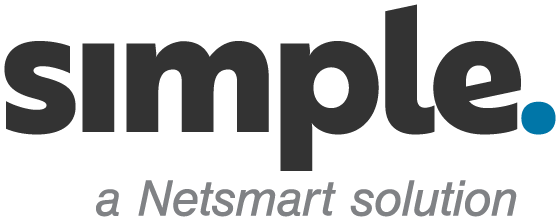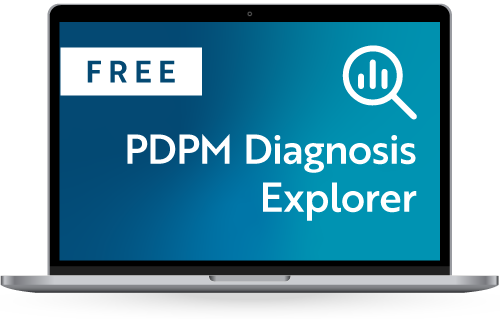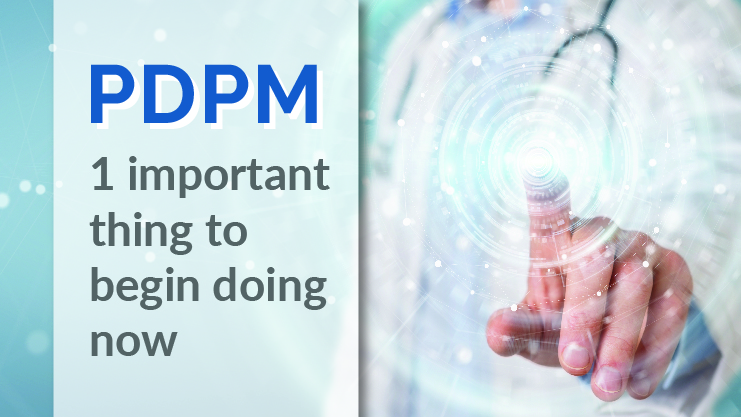Beginning Oct. 1, 2019, the new Patient-Driven Payment Model (PDPM) will shift the way your skilled nursing facility is reimbursed for Medicare A services. PDPM will replace the current RUG-IV system, introducing a whole new way to calculate SNF reimbursement.
From RUG-IV to PDPM
The current RUG-IV system incentivizes the use of therapy minutes as the basis for payment. Under PDPM, however, every resident will receive a case-mix classification, which will drive the daily reimbursement rate for that resident.
The case-mix classification consists of five components:
- Physical Therapy (PT)
- Occupational Therapy (OT)
- Speech Language Pathology (SLP)
- Nursing
- NTA
On Tuesday, Dec. 11, CMS released a SNF PPS: Patient Driven Payment Model presentation, answering frequently asked questions about the transition. The presentation provides a snapshot of the payment model, patient classifications under PDPM, patient classification examples, MDS changes, and much more.
A key takeaway from the CMS presentation: Coding diagnosis information accurately and efficiently is more important than ever, as it will make up
1 important thing to begin doing now
Remember: There will not be a transition period between RUG-IV and PDPM. It’s not too early to start preparing for PDPM. You can begin by identifying affected processes and adjust your SNF’s workflow and resources accordingly.
When planning for PDPM, it’s important to use data to support your clinical decisions. Under PDPM, CMS will focus heavily on measuring and rewarding quality outcomes, so it’s crucial to leverage your current data to ensure the right care is provided to meet individual residents’ needs.
To lay the groundwork for proper clinical data under PDPM, you must correctly report clinical conditions for diagnosis and MDS accuracy.
Here’s the critical PDPM practice you should begin doing immediately:
Ensure the primary diagnosis is correctly entered in I8000A. Be sure to do this for every resident and make this a standard practice leading up to the changeover to PDPM.
Completing I8000A accurately will help you proactively prepare for upcoming PDPM reimbursement requirements. At SimpleLTC, we’ve polled many of our largest customers, who have confirmed they are following this practice. Therefore, we recommend that all our customers follow this best practice.
SimpleLTC’s commitment to help
We’re committed to helping you stay current with industry changes, which includes constantly updating our products to help you maintain regulatory compliance and leverage the value of your MDS and clinical data.
One way we’re helping our SNF customers make the difference between success or failure is through predictive, real-time MDS analytics. Sign up for your free demo to learn why over 1,000 facilities trust SimpleAnalyzer™ to improve quality measures, reduce rehospitalizations, maximize QRP compliance, and more.





16 Comments on “PDPM: 1 important thing to begin doing now”
CHERYL.COLEMAN@consulatehc.com
Appreciate it.
Glad to help!
Could you please notify me on the next webinar on PDPM as today’s webinar was full; thanks.
Hi David, we don’t have another webinar scheduled at this time. However, we will post a recording of the webinar, along with the handouts, after the live event. You can access them on this page: https://www.simpleltc.com/pdpm-preparation-webinar-registration/
I would appreciate every notification on this as well. Thank you so much.
Hi Janie, you can subscribe to receive future notifications on this page: http://www.simpleltc.com/subscribe. Thanks!
Please send me information. Thanks
Hi Carol, you can subscribe to receive future notifications on this page: http://www.simpleltc.com/subscribe.
Please let me know of any webinars on PDPM.
Hi Barbara, please subscribe to receive notifications about upcoming webinars: http://www.simpleltc.com/subscribe. Thanks!
When is the next PDPM training? Is there a link to sign up for it
Hi Rhonda, our next PDPM webinar will be Tue, Feb 19. Please subscribe to receive notifications when registration is available. Thanks!
Jsorrell@rnct.com
how do I get a copy of the slides from todays webinar
Hi Brenda, we didn’t have a webinar today. To ensure you get notified of future webinars, please subscribe to our email list. You can also access our previous webinars and slides here. Thanks!